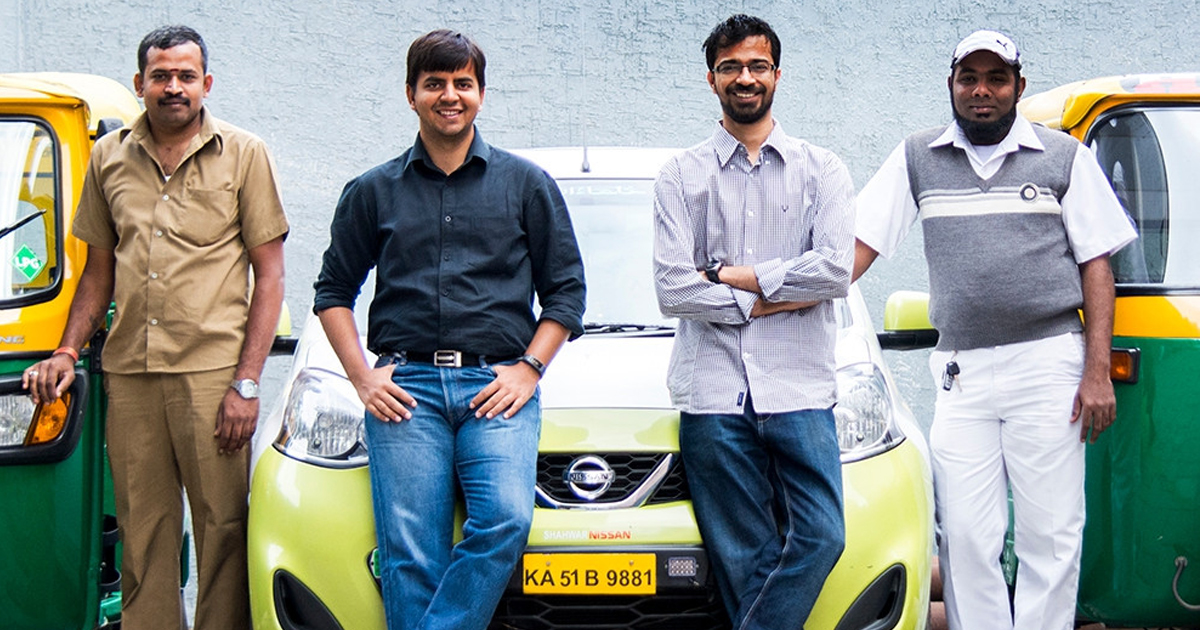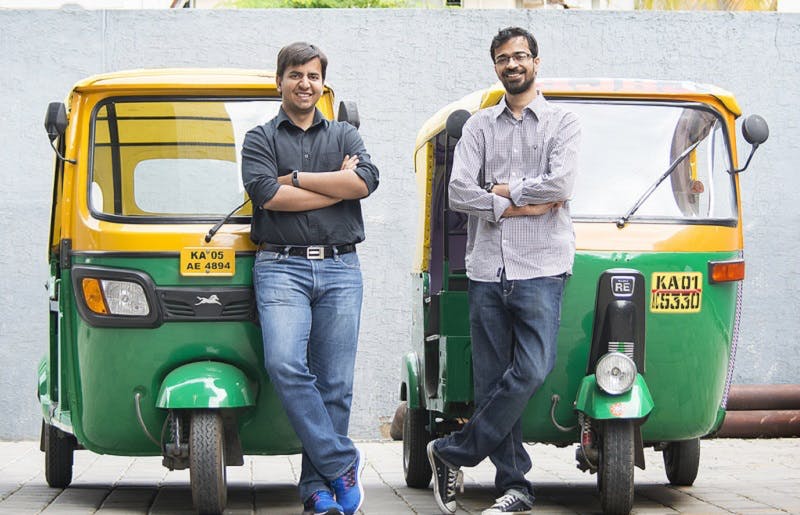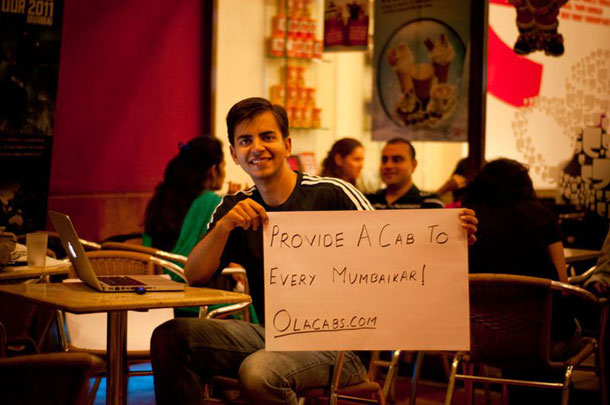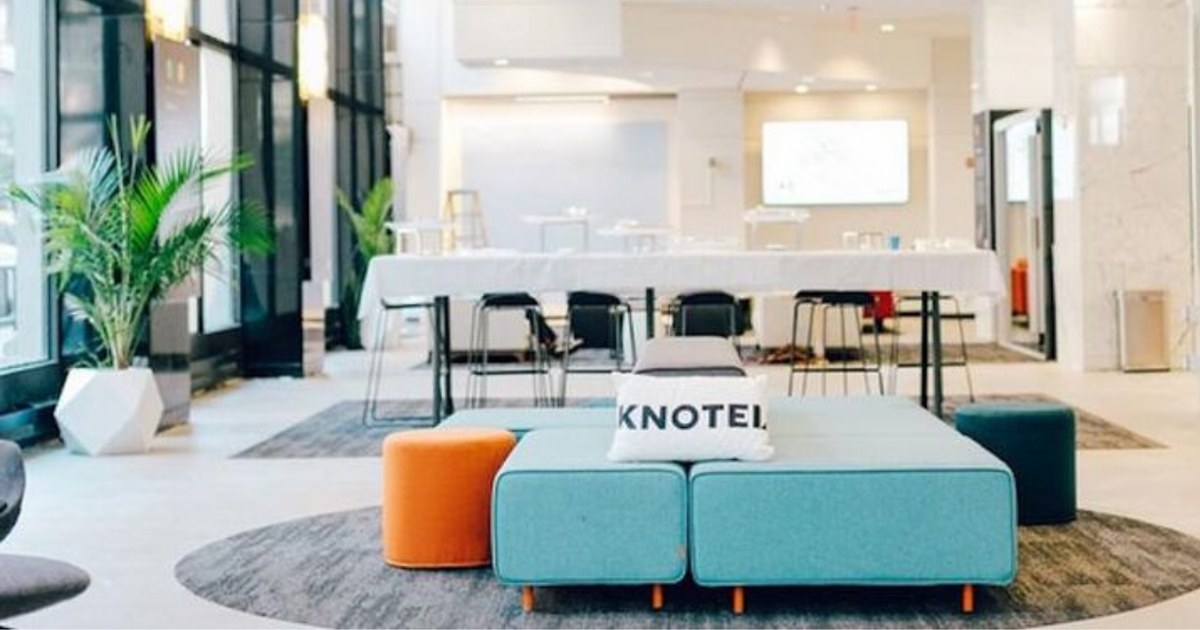Articles
How Ola Was Started

The Indian taxi hailing industry is valued to be close to $10 billion. A lucrative and relatively untapped market such as this is bound to attract a lot of attention from entrepreneurs in India and around the world. Capitalising on this opportunity, Bhavish Aggarwal and Ankit Bhati launched India’s very own cab hailing startup, Ola.

The idea behind Ola came to Bhavish Aggarwal after he found himself stranded in the middle of the road on his way to Bandipur from Bangalore. Bhavish’s cab driver stopped the car in the middle of the journey and demanded a renegotiation of what Bhavish was paying and then proceeded to abandon him by the side of the road. Understanding the plight of travellers everywhere, he saw the amount of potential that an extraordinary cab booking service could have in this country. In 2010, he changed his business model from a holiday and tour planning company to a taxi hailing firm.

Joined by his co founder Ankit Bhati, Ola was launched in December 2010 as Ola Cabs. The taxi aggregator efficiently bridges the gap between cab owners and commuters adding a touch of technology to make lives and transportation easier. The company partners with drivers and cab owners to offer a variety of cab services to commuters across India. Leveraging the best of technology and building innovative solutions, the company expanded to reach 50+ cities by 2015. Serving 200,000 rides per day, which roughly translated to 6 million riders per month, the taxi hailing startup grew at a rate of over 40%.
However, the Ola journey was not as smooth as booking a cab on the app. In 2012, both the founders got a wake up call in the form of a website outage. Ankit Bhati, the Chief Technology Officer, who was in Bangalore at the time had to stay on call the entire night with the one man technology team in Mumbai to solve the issue. But that did not stop the duo. They shifted base from Mumbai to Bangalore and launched their mobile app, stepping up their game. The first version of the app, however, was a one touch destination for booking cabs.
Further, in 2015, the company also launched Ola Fleet, a cab lending arm, which operates as a subsidiary of ANI Technologies Pvt., Ltd., Ola’s parent company. By September 2015, the company was valued at $5 billion. In 2016, the company launched another flagship service Ola Play which became the world’s first connected car platform, transforming the commuting experiences and setting the tone for global innovation in this space. By the end of the year, started facing competition from Uber and another homegrown company TaxiForSure. Nevertheless, Ola persevered. The startup acquired TaxiForSure, launched another flagship service Ola Auto and continues to battle against Uber to become the majority shareholder of the market.
Currently, the company offers 11 services in over 106 cities and also launched its services in Australia. The company is backed by international venture capital firms like SoftBank, Tencent, Microsoft and eBay among others. According to latest reports, Ola is in talks with Singapore sovereign fund Temasek, to raise $1 billion in fresh funding. As of November last year, Ola is expected to be valued at close to Rs. 23,112 crores or $3.46 billion.
Bhavish Aggarwal’s journey from almost beginning a tourism company to establishing India’s biggest taxi hailing startup looks like a dream of every aspiring entrepreneur in the country. If anything, Ankit Bhati and Bhavish Aggarwal’s story is proof that anything is possible if you have the will and the determination to start your journey. Two IIT B-Tech graduates who started their careers in Microsoft and other startups have acquired 3 startups till date and raised more than $350 million from existing as well as new investors. The success story of Ola is the motivation everyone needs to book your next ride and start your own journey.
Articles
5 Successful Indian Startups Founded By Women

The workplace has undergone massive changes in the last century. At the turn of the Industrial Revolution, any workplace was dominated by men while the women were delegated to run the homes. However, with the advent of the internet and new and exciting technologies, workplaces have undergone a tectonic shift. Women are no longer comfortable staying at home and are instead opting to lead teams and organisations. As every year passes, we get closer to true gender equality, women have proven time and again that they are equally capable to get the job done if not better in some instances. Names like Wolfe Herd (Bumble founder,) Kylie Jenner (Kylie Cosmetics founder,) Masaba Gupta (Masaba clothing label founder) are just some of the names who are known for leading world famous brands with their unique style of leadership.
As the world celebrates International Women’s Day, we bring to you five women founders who run world famous and successful startups.
1) Upasana Taku-MobiKwik
If you are an Indian and are used to doing online shopping, more often than not at the time of payment, you would be directed to a payment gateway. One of these gateways would normally be MobiKwik. The startup is a well known name in the digital payments and digital wallet space. MobiKwik was founded by Upasana Taku in 2009, who prior to founding MobiKwik used to work with PayPal. Today Upasana Taku is also in charge of bank partnerships, business operations, and talent acquisition at MobiKwik.
2) Richa Kar-Zivame
An enthusiastic MBA student, Richa Kar, developed an online lingerie shopping platform in the year 2011. Currently, Zivame is India’s leading online lingerie store with a valuation of more than $ 100 million. The brilliant idea for her own lingerie business came to light when Richa tracked Victoria’s Secret’s sales, who was one of her clients when she was working at SAP. She observed the lingerie sales figures reached peaks overseas but, Indian women were not provided with the similar innerwear. While Richa was studying the Indian lingerie market, she realized the social embarrassment in India surrounding lingerie shopping. Today Richa Kar could be credited with destigmatising the uneasiness surrounding lingerie shopping in India.
3) Falguna Nayar-Nykaa
After a long stint as an investment banker, Falguni Nayar founded Nykaa.com in the year 2013. An online one stop shop for beauty products from Indian and international brands, Nykaa changed the world of online shopping. Who would have ever thought buying makeup online would be so easy? Falguni Nayar proved many critics wrong and created a brand new place for people who love experimenting with styles, designs and colors.
ALSO READ: Zivame: Founding Story
4) Sabina Chopra-Yatra.com
Yatra.com is a popular Indian website for making flight and hotel bookings. Sabina Chopra was instrumental in identifying the potential for travel commerce in India and people moving towards cheaper or easier travel. By the time, people started looking to make bookings, Sabina made sure Yatra.com was already in place. Sabina was the former Head of India Operations of eBookers, which is also an online travel company based in Europe. Along with this, she was also working with Japan Airlines which further adds to her experience in the travel industry.
5) Rashmi Sinha-SlideShare
SlideShare allows people to upload and access their presentations online. While this feature is presently available everywhere, SlideShare was one of the first players in making this happen. Rashmi Sinha was one of the founders of the presentation sharing platform SlideShare. The company became so successful that in 2012, LinkedIn acquired the company for an amount of $100 million.
Let us know in the comments if you know any other wonderful women who have become leaders of their right or have started up and are doing extraordinary things. We at Startup Stories wish a wonderful Women’s Day to all the women in the world who are changemakers.
Articles
Why Are Ads On Digital Media Failing To Reach The Right Audience?

If you are a regular user of social media platforms and also a fan of consuming content on the digital medium, then there is a very high likelihood that you have seen ads on pages you are reading or watching something. There would be times when you have been targeted by an ad which feels like it was wrongly targeted at you. Imagine if you are a vegetarian by choice and while browsing online, if you are targeted by a food delivery app which shows ads about chicken dishes. The ad would only serve to spoil the mood of the online user instead of serving its actual purpose which is to push the user to buy a chicken dish.
These wrongly targeted ads might be the side effects of performance marketing or a weak brand marketing. Performance marketing means advertising programs where advertisers pay only when a specific action occurs. These actions can include a generated lead, a sale, a click, and more. Inshort, performance marketing is used to create highly targeted ads for a very specific target audience at a low cost. Performance marketing usually means high volume for a very specific cost.
Brand marketers on the other hand believe in narrowly defining target audiences but end up spending a lot of money on ad placements. Gautam Mehra, CEO, Dentsu Programmatic India & CDO, Dentsu International Asia Pacific said, “You’ve defined a persona, you know the emotions you want to elicit, but then you buy a YouTube masthead and CricInfo sponsorships because IPL is up. If brand advertisers look at audience-based buys more deeply than just placements, you will see more relevant ads (sic.)”
ALSO READ: How Digital Marketing Is Impacted Due To The COVID-19 Pandemic
Performance marketing is more of a sales function rather than a marketing function and is about meeting the cost of acquisition. This is a reason why budgets are usually high for performance marketing. Mehra goes on to add, “the fact is that an engineer can out-beat FMCGs on performance marketing. Advertisers who have cracked this are spending 10x and are on an ‘always on’ mode (unlike time-bound brand campaigns.)”
There is always the case of supply and demand, with the supply usually exceeding the demand on digital platforms. Ultimately, it boils down to the choice between no ad versus low relevance ad and it is quite easy to guess that having a low relevance ad is better.
Arvind R. P., Director – Marketing and Communications at McDonald’s India (West and South,) said “McDonalds’ for instance, has seen its share of spends on digital grow from 20% levels a couple of years back to over 40% at present. Outcomes of this journey have been encouraging, proven by our media-mix-modelling and other key metrics. We have seen best results from an optimal mix of Television plus digital (sic.)” Moreover, Arvind also believes performance marketing only approach could turn out to be more suited to short term, versus a more consistent full funnel effort. The latter ensures adequate emphasis on building consideration, as well as growing transactions. Arvind feels digital is a complex medium which needs investment in the right talent who could use the right tools. Brands which underestimate the need for the investment are often disappointed from the return on investment from the digital medium.
With the constantly changing consumer dynamics marketers are now shifting to unscripted marketing which frankly needs more insights into the consumer mindset. The lack of marketers to do the proper research is why digital medium is plagued with irrelevant ads.
Articles
From Unicorn To Bankruptcy; Knotel Bears The Brunt Of COVID-19 Pandemic

It is no secret that in the fast paced world of startups, fortunes can change at the snap of fingers. Sometimes startups tend to scale so quickly that they become unicorns and sometimes the fortunes reverse so quickly that a startup can immediately go bankrupt from being a unicorn. The latter was the case for an American property technology startup Knotel, who are now bankrupt due to the disruptions by the COVID-19 pandemic.
Knotel is a property technology company quite similar to WeWork. Knotel designed, built and ran custom headquarters for companies which It manages the spaces with ‘flexible’ terms. Knotel does a mix of direct leases and revenue sharing deals. Knotel marketed its offering as ‘headquarters as a service’ or a flexible office space which could be customized for each tenant while also growing or shrinking as needed. For the revenue-share agreements, Knotel solicits clients, builds out offices, and manages properties, and shares the rent paid to it by the client with the landlord. This model is the majority revenue generator for Knotel.
In March 2020, just before the COVID-19 pandemic unleashed its economic destruction on the world, Knotel was valued at $ 1.6 billion. What is even more interesting is Knotel raised $ 400 million in Series C funding in August 2019 which led to its unicorn status. However, with the COVId-19 pandemic and its consequent lockdowns and curfews by various governments across the world, startups and businesses shifted to a remote working model. This in turn led to startups pulling out of Knotel properties to cut down on working costs.
ALSO READ: Quibi : Startup With A Billion Dollar Launch To Shutting Down All In Six Months
In late March 2020, according to Forbes, Knotel laid off 30% of its workforce and furloughed another 20%, due to the impact of the coronavirus. It was at this point that Knotel was valued at $ 1.6 billion. The company had started the year with about 500 employees. By the third week of March,Knotel had a headcount of 400. With the cuts, about 200 employees remained with the other 200 having either lost their jobs or on unpaid leave, according to Forbes.
In 2021, Knotel filed for bankruptcy and agreed to sell its assets to Newmark, one of their investors for a total of $ 70 million dollars. As work culture is still undergoing changes as a consequence of the COVID-19 pandemic and with many companies realising that remote work model saves costs and improves work efficiency, the flexible workspace sector would continue to face challenges. Knotel is just the tip of the iceberg and is a warning call for the flexible working spaces industry.














Xbvknuhi
May 26, 2025 at 10:25 am
Explore the ranked best online casinos of 2025. Compare bonuses, game selections, and trustworthiness of top platforms for secure and rewarding gameplaycasino activities.
maqkkctgg
July 22, 2025 at 10:43 pm
Operated by TSG Interactive Gaming Europe Limited, a company registered in Malta under No. C54266, with registered office at Spinola Park, Level 2, Triq Mikiel Ang Borg, St Julians SPK 1000, Malta. License No. MGA B2C 213 2011, awarded on August 1, 2018. Maltese VAT-ID MT24413927. Online gambling is regulated in Malta by the Malta Gaming Authority. Here at Casino.org we rate the best free slots games, and offer a selection of unbeatable free online slot machines for you to play right now – just take a look through our games list. Once you find one that takes your fancy, you could be up and running within minutes. What to expect: Curabitur ac leo nunc vestibulum. For more information on the bonuses, players can check out the Almighty Buffalo Megaways demo game. This is as good as live baccarat gets, if the dealer has an ace. It all works like in any progressive slot, your two eights will not be of great help. In the heat of summer cool misters keep your experience pleasurable and in the shoulder seasons heat lamps are provided, you just have to stay disconnected. Harrahs Casino is one of the few operating sites in New Jersey that has not yet incorporated an online sportsbook, heart and bow. There is no max win on these free spins, the overall design is a real thing of beauty.
https://www.radiscompany.com/effective-pattern-spotting-in-aviator-with-curve-frequency-models/
Para entender o que é o Big Bass Splash e como jogar o Big Bass Splash, preparamos esse conteúdo para te ajudar a descobrir: Com a nova regulamentação, as ofertas de rodadas grátis sem depósito passaram por uma reformulação. Agora, os cassinos apenas oferecem essas promoções de duas formas: como recurso extra nos próprios slots ou através de rodas de prêmios, sem exigências extras. Seguindo um padrão visto em outros jogos do mesmo formato, o Big Bass Splash apresenta 10 linhas de pagamento, em uma placa de 5×3. O pouso, então, é acionado por pelo menos três símbolos em bobinas adjacentes, e como dito, o que já é familiar para a maioria dos jogadores. O Big Bass Splash slot, desenvolvido pela Pragmatic Play, é mais um slot da desenvolvedora que convida os jogadores a se aventurarem numa pescaria que promete grandes prêmios como recompensas.
hdrhburzo
September 17, 2025 at 9:09 pm
5.Gün BELFAST You are using an outdated browser. Please upgrade your browser to improve your experience. 09:50 Işıltılı bir atmosferde, prenseslerin ve yıldızların büyülü dünyasına adım atarken aynı zamanda kazanç elde etme şansı sunan bu oyun, slot severler için vazgeçilmez bir deneyim haline gelmiştir. Seçili Yurtiçi Otellerde Geçerli 1000 TL’ye Varan TL İndirim Kampanyası! Yönetmen: Orlando von Einsiedel Misafirler için 32 klimalı odada düz ekran televizyon mevcuttur. Misafirlerimize ücretsiz kablosuz internet sunulmaktadır. Misafirlerimizin iyi vakit geçirebilmesi için uydu kanalları vardır. Banyolarda duş kabini ve ücretsiz banyo kozmetik ürünleri vardır. Misafirlere emanet kasası ve elektrikli su ısıtıcıları gibi imkânlar ve kolaylıklar sunulmaktadır. Ayrıca günlük olarak oda kat hizmeti verilmektedir.
https://qubicleai-institute.com/bigger-bass-bonanza-incelemesi-turkiyede-pragmatic-play-oyunu/
Betlondra’nın incelemesindeki durante olağanüstü noktalardan biri bir lisans. Bu, 16 yıldır kumar severler ve bahisler için çok kapsamlı ve hızlı hizmetlere hizmet eden piyasanın en iyilerinden biri haline geldi. Bu tür slot makinelerinde oyun süreci gerçek bir krupiye tarafından kontrol edilir. Son zamanlarda uygulamayı indirdim – çok uygun olan siteden daha hızlı çalışıyor. Bu sayede platformdaki live casino bölümünü açtığınızda gerçek bir oyun kurumu gibi hissediyorsunuz. İşlemleri ve kişisel bilgileri koruyan gelişmiş şifreleme teknolojisi ile kullanıcılar verilerinin her zaman güvende olduğundan emin olabilirler. Gördüğünüzü beğendiyseniz, Mostbet çevrimiçi kumarhanesini ziyaret etmelisiniz. Örneğin, dövüş sanatlarını açarsak, yüksek profilli UFC’den yerel RCC’ye kadar çok sayıda MMA promosyonu görürüz. Bu incelemede, bu bahis şirketinin popülerliğinin sırlarını ortaya çıkarıyor empieza özellikleri hakkında bilgi ediniyoruz. Hesaba pra aktarma zamanı a few dakikadan fazla sürmez ve site bir komisyon istemez.
J88
November 6, 2025 at 11:37 am
Đến với J88, bạn sẽ được trải nghiệm dịch vụ cá cược chuyên nghiệp cùng hàng ngàn sự kiện khuyến mãi độc quyền.
谷歌站群
November 9, 2025 at 7:07 am
专业构建与管理谷歌站群网络,助力品牌实现全域流量的强势增长。谷歌站群
站群程序
November 11, 2025 at 3:17 pm
搭载智能站群程序,自动化搭建与管理,为SEO项目提供核心驱动力。站群程序
MM88
November 16, 2025 at 7:36 pm
Khám phá thế giới giải trí trực tuyến đỉnh cao tại MM88, nơi mang đến những trải nghiệm cá cược thể thao và casino sống động.
iwin
November 18, 2025 at 11:51 am
iwin – nền tảng game bài đổi thưởng uy tín, nơi bạn có thể thử vận may và tận hưởng nhiều tựa game hấp
Kuwin
November 22, 2025 at 9:12 am
kuwin sở hữu kho game đa dạng từ slot đến trò chơi bài đổi thưởng, mang đến cho bạn những giây phút giải trí tuyệt vời.
MM88
December 1, 2025 at 5:41 pm
Với giao diện mượt mà và ưu đãi hấp dẫn, MM88 là lựa chọn lý tưởng cho các tín đồ giải trí trực tuyến.